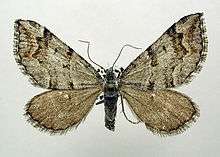Carsia sororiata
| Carsia sororiata | |
|---|---|
 | |
| Scientific classification | |
| Kingdom: | Animalia |
| Phylum: | Arthropoda |
| Class: | Insecta |
| Order: | Lepidoptera |
| Family: | Geometridae |
| Genus: | Carsia |
| Species: | C. sororiata |
| Binomial name | |
| Carsia sororiata (Hübner, 1813) | |
| Synonyms | |
| |
Carsia sororiata, the Manchester treble-bar, is a moth of the Geometridae family. It is found in northern and central Europe, the Urals, Siberia, the Far East, northern Mongolia and in North America from Alaska to Newfoundland and to New Hampshire.

The wingspan is 20–30 mm. The basic colour of the forewings is slate grey, light grey to white grey. Two distinctive, wide lines cross the front wing. They are light brown, brown to black-brown. The interior cross line is almost straight, the exterior cross line is bent and has two outward pointing spikes. The subspecies occurring in Central Europe ssp. imbutata has a brownish yellowish to reddish brown outer field at the points of the outer cross line. Very elegant lines are sometimes found. In some specimens, the two lines form "bridge" in the posterior half of the wing. The fringes are alternately bright and dark. An apical extension to the reddish-brown field extends from the apex.[1]
Adults are on wing from July to August.
The larvae feed on various Vaccinium species (including Vaccinium uliginosum, Vaccinium oxycoccos and Vaccinium myrtillus) as well as Rubus arcticus.
Subspecies
- Carsia sororiata sororiata
- Carsia sororiata alpinata Packard, 1873
- Carsia sororiata labradoriensis (Sommer, 1897)
- Carsia sororiata thaxteri Swett, 1917
- Carsia sororiata columbia McDunnough, 1939
- Carsia sororiata anglica Prout, 1937
- Carsia sororiata imbutata (Hubner, 1813)
References
External links
| Wikimedia Commons has media related to Carsia sororiata. |
| Wikispecies has information related to: Carsia sororiata |